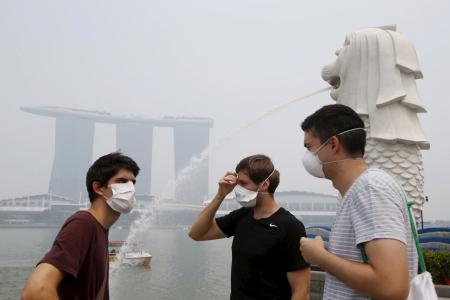PSI goes up: Singapore air quality 'very unhealthy'
Singapore’s air quality reached "very unhealthy" levels on Thursday (Sept 24) as thick smog from forest fires in Indonesia choked the country.
The National Environment Agency (NEA) said in an advisory:
"The hazy conditions in Singapore have further deteriorated since last night, as denser haze from Sumatra has been blown in by the prevailing southerly winds."
It added: "The current hazy conditions are expected to persist, and there could be a further deterioration in the air quality later in the day."
At 6pm, the 3-hour PSI hit as high as 292.
| 1am | 2am | 3am | 4am | 5am | 6am | 7am | 8am | 9am | |
| 3-hour PSI | 245 | 233 | 207 | 181 | 170 | 166 | 171 | 183 | 197 |
| 10am | 11am | 12pm | 1pm | 2pm | 3pm | 4pm | 5pm | 6pm | |
| 3-hour PSI | 219 | 244 | 262 | 260 | 239 | 225 | 232 | 262 | 292 |
At 6pm today, the 24-hour PSI was 204-248. The "very unhealthy" range is 201 - 300.
NEA advised healthy persons to "avoid prolonged or strenuous outdoor physical exertion".
The elderly, pregnant women and children are also urged to minimise outdoor activity.
Many people seem to be avoiding the outdoors, as AFP reported that many parks, which are usually busy on a public holiday, were near deserted.
Some who ventured out did so with masks on.
Eating with masks on
Chinese-language daily Lianhe Wanbao reported that a seafood restaurant at Punggol End said it has been distributing masks to customers.
Some of the eatery's customers have even resorted to keeping their masks on throughout their meal, pulling open only a small gap at the bottom to put food into their mouths.
Singapore has been cloaked in smog for about three weeks.
Indonesian President Joko Widodo has pledged to crack down on companies and individuals behind the fires, which are a cheap but harmful way of clearing vast tracts of land for plantations.
The haze situation has been made worse this year by an El Nino weather system, which produces tinder-dry conditions in Indonesia and increases the risk of fires.
In 2013, the PSI had peaked at a hazardous level of 401.
Sources: AFP, Lianhe Wanbao
Get The New Paper on your phone with the free TNP app. Download from the Apple App Store or Google Play Store now


